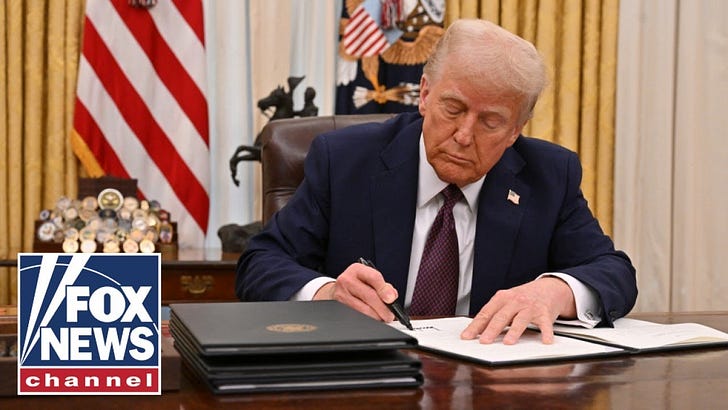How Trump’s Transgender Military Ban Might Be Defensible
But his executive order undermines itself
Update: On May 6, 2025, the U.S. Supreme Court held that the Trump administration may proceed with a plan to bar transgender people from serving in the military. The one-page order — delivered over the dissent of the three liberal justices — lifted a ruling by a district court in western Washington state (Seattle/Tacoma) that had paused the administration’s ban.
The stay of the lower-court's action allows the transgender exclusion to take effect while legal challenges continue, but suggests the highest court would ultimately uphold the executive branch's right to set recruitment standards.
While big LGBTQ+ lobbies predictably denounced what they described as the Supreme Court's sanctioning of anti-trans discrimination, others have pointed out the military doesn't accept recruits for a number of lessor conditions, including too much acne on your back(!) or a stunted toe. And (as I noted below) insulin-dependent diabetics are excluded as nondeployable. So not barring individuals dependent on cross-sex hormones seems a preferential exception to standard practice, rather than targeted discrimination.The White House on Jan. 27 issued an executive order, Prioritizing Military Excellence and Readiness, that directs the Department of Defense to prohibit service members who identify as a gender other than their birth sex from enlisting or serving in the armed forces, and to bar the use of “invented and identification-based pronoun usage.”
The order states that:
Consistent with the military mission and longstanding DoD policy, expressing a false ‘gender identity’ divergent from an individual’s sex cannot satisfy the rigorous standards necessary for military service. Beyond the hormonal and surgical medical interventions involved, adoption of a gender identity inconsistent with an individual’s sex conflicts with a soldier’s commitment to an honorable, truthful, and disciplined lifestyle, even in one’s personal life. A man’s assertion that he is a woman, and his requirement that others honor this falsehood, is not consistent with the humility and selflessness required of a service member.
The order would be more defensible if rather than veering into whether transitioning ones gender identity is dishonorable and untruthful, not to mention selfish, the administration had instead focused on practical issues. A point made in passing that should have been central is the reference to “the hormonal and surgical medical interventions involved.”
An argument certainly could be made (but wasn’t in the president’s order) that just as insulin-dependent diabetics are barred from enlisting — as insulin can’t be guaranteed to deployed troops — so, too, it would seem reasonable to bar transgender personnel dependent on the lifelong use of cross-sex hormones, as people who have physically transitioned (or are in the process of transitioning) typically are.
For current or would-be service members who have not transitioned through hormone therapy and surgeries, perhaps don’t intend to, but nevertheless “identify” as the other sex, the case could be made that those with male genitalia shouldn’t be sleeping, changing, and showering with females, and that biological women should not be doing the same with men, for all the reasons why putting naked men and women together is considered a risky business, especially for women.
There are other practicalities to consider as well. As the New York Post reported:
The Pentagon has spent more than $15 million on transgender medical for military personnel since Jan. 1, 2016 — though the practice was paused for a time during Trump’s first term. The majority of those funds — about $11.5 million — were used for psychotherapy, while about $3.1 million went toward 243 gender reassignment surgeries, according to a 2021 report by Military.com.”
If transgender service members require psychotherapy and/or gender-reassignment surgeries, then barring them from enlisting or serving makes perfect sense.
That view is also supported by a number of lesbian and gay service members and veterans. As The Scroll’s Adam Lehrer reports:
Rob Smith, an openly gay combat veteran, argues that the removal of trans people from the military is the right move because, he says, transgender service members are non-deployable, meaning that while their treatments are covered by Veterans Affairs, they effectively can’t serve the military primarily because they require ongoing medical treatments that are not compatible with military readiness. So, while some are criticizing the removal of 8,000 service members from the military, Smith and others assert that the executive orders remove 8,000 non-deployable service members and replace them with 8,000 deployable members.
That 8,000 number, by the way, is considered a high-end guesstimate from the Biden administration, although trans advocates have come up with even higher figures. The current Defense Department, however, says 4,240 service members, or about 0.2 percent of those in uniform, have a diagnosis of gender dysphoria.
Arguments around practical matters and the realities of military service, however, likely won’t be debated. Instead, the use and misuse of “truthfulness” and “honor” as motivating factors behind the ban will dominate, degrading attempts to find and implement a reasonable policy — and providing ammunition for groups suing to block the ban.
Interestingly, it’s rather clear that Trump put the kabbash on rightwing attempts to revisit gay people serving openly in the military. In December Politico reported that now-confirmed Defense Secretary Pete Hegseth had previously called policies allowing both gay and transgender troops into the military a “Marxist agenda” (meaning cultural Marxism, presumably).
But when asked, after Trump had nominated him to be his Defense Secretary, whether he now supported gays serving in the military, Hegseth bluntly responded, “Yes.”
Subscribe to receive future posts by Stephen Henry Miller at no cost:

